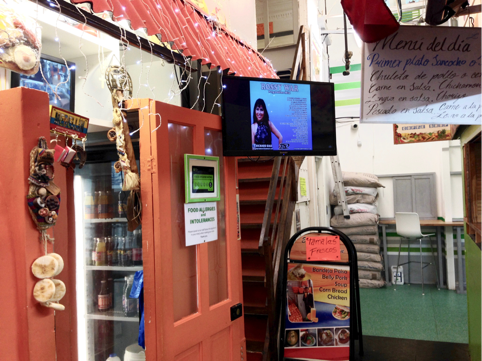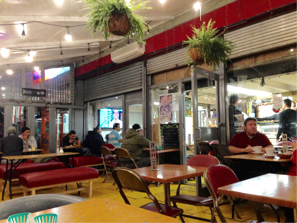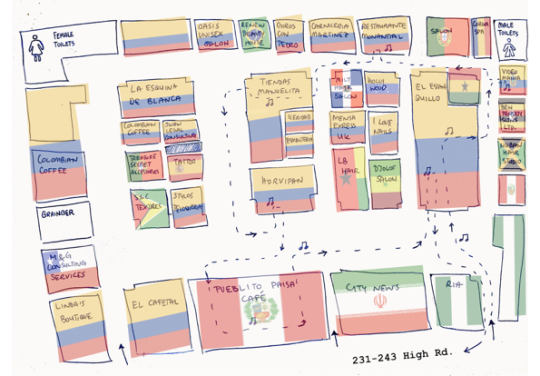#Rita's spacial awareness varies
Explore tagged Tumblr posts
Text
I read something about HimeRita Kabedon...

Himeno was just showing off some Moffun Earring prototypes and Rita just wanted to take a closer look 😏
#Rita's spacial awareness varies#so getting up close and in Himeno's personal space for a pair of cute earrings is highly possible#even unintentionally kabedon-ing her to do so 😂#doodling the boys having huge freakouts over such gay energy caused by people so dense is so fun 😂😂#kingohger#king ohger#ohsama sentai kingohger#rita kanisuka#rita kaniska#himeno ran#hymeno ran#sentai doodles#doodle#himerita#ritahime
28 notes
·
View notes
Text
Taking back the market: An auditory dérive through Pueblito Paisa

Dérive (“drift”) in psychogeographic terms, suggests to derive the meaning of a place by passing through its varied ambiences with a playful and constructive awareness of the space and the encounters which it facilitates (Debord 1958). The concept offers a lens through which I will explore microclimates within the Seven Sisters market in Tottenham. My approach to this study was heavily influenced by spacial theorists such as Henri Lefebvre and David Harvey, whose book “Rebel Cities” I happened to be reading at the time of discovering the market. Pueblito Paisa, strongly resembles Harvey’s idea of a “microstate”, which he describes as an autonomously functioning fragmented state, that is born out of the stark polarization of wealth in highly urbanized cities (Harvey 2013, p.15). In the market, I’m also reminded of the concept of heterotopia, which according to Foucault, is a non-hegemonic space of “otherness” and, in the case of Pueblito Paisa, illustrates the result of social heteronomy, a product of class systems within urban capitalist centers. In this heterotopia however, “ethnic, gender and language inequality are key factors in encouraging agency and entrepreneurship which contribute to a sense of belongingness, identity and self-representation” (Roman-Velazquez 2013).
This fieldwork project, in the shape of diary entries and a sound map, reflects an exploration of the market through dérive. It aims to shed light on the complex social fabric that forms Pueblito Paisa’s community and illustrate the important role that such communities play in today’s urban context.
The market (When referring to the market, the names “Latin Village”, “Seven Sisters market”, and “Pueblito Paisa” are used interchangeably.)
Latin Village, located at 231-243 High Rd., contains 39 shops, of which 23 are owned or leased by Latin American retailers (Roman-Velazquez 2013). After Elephant & Castle in Southwark, The Seven Sisters market has the second highest concentration of Latin American business in London (Cabrera 2017). Since 2004, Haringey Council and Grainger development company have been negotiating a regeneration scheme for the area which requires the demolition of the market to make way for 196 non-affordable residential units and 40,000 sq. ft of retail space. Although the developers promise to provide a new long term home for the Seven Sisters Market within this space, the market community fears that it will disintegrate and be unable to afford the rent in the new development (https://tottenham.london/WC).

1. December: My first visit to Pueblito Paisa
I’m sitting in Latin Village’s Peruvian restaurant, “Pueblito Paisa Café”, which looks out on to the Seven Sisters station, allowing a glimpse of the outside world and reminding me that I’m in London. The restaurant is the only place I’ve spotted any other “gringxs”, by which I’m referring to people like myself. Regarding most of the market community is Latin American and speak little to no English, I completely forget my geographic location.
Music is ubiquitous. Almost every shop has its own speakers, playing a selection of Bachata, Salsa, Merengue and Cumbia tracks. Multiple tv-screens hang above the aisles, displaying the, mostly Youtube, playlists. Music is a vital element of the market’s soundscape and its impact on people’s uplifted mood is striking. Conversations are interrupted by familiar tunes, when spoken dialogue turns in to a song, whistle or dance. While wandering through the market like a tourist, I meet Alejandro Gonzalez Gortazar, a Cuban journalist and artist who’s been in the UK for 10 years and has known the market equally as long. He’s helping his friend Fabian, who owns the restaurant “Monantial”, with renovations. Having heard that the market would soon be moved to a temporary location, I am surprised to see people investing time and money in improving a space which developers were threatening to demolish. He happens to break for a cigarette so I take the chance to approach him and introduce myself, hoping he would be able to tell me more about the market. Luckily, he’s eager to speak and begins to talk about Pueblito Paisa’s foundation. According to Alejandro, a group of Colombian immigrants discovered the market about 20 years ago, which then was a half vacant market run by mainly African traders. Noticing they could rent stalls for cheap, they took their chances and started businesses, sending out for kin in Colombia to join in on the opportunities.
All of the market’s stalls have a commercial purpose, but still people seem to be using the space as a community center. There’s a notion of informality and inclusiveness at Pueblito Paisa which allows the general public access to and usage of the space without the pressure to consume or spend money. I think that markets function as important places of integration and solidarity for diverse communities and vulnerable people, where they can find affordable (and sometimes even free) food, social networks and even job opportunities. So why talk about Pueblito Paisa? And why through my eyes and ears, a gringa who has no prior connection to the market or the Latin American community.My sense of “rootlessness”, having been raised in Austria by a Canadian mother and an Iraqi father, has sparked my interest in the formations of “homes away from home” by immigrants and displaced peoples. At Latin Village, sound strikes me as one of the most powerful stimulants in recreating this sense of home. The omnipresence of Latin-American music, Spanish speaking voices, the sizzling of empanadas in the deep friers. Modern technology has enhanced the mobile notion of sound, allowing displaced people to reclaim space through sound and reestablish a sense of “home” wherever they go.Pueblito Paisa offers a fascinating location to study sound’s capacity to communicate impressions of a vibrant community’s social dynamics which is experiencing a period of transition. The Seven Sisters regeneration plans will uproot a well established community and possibly eliminate its collective memory. All I feel that my project can achieve is to exhibit the importance of this market to the livelihood and wellbeing of a community which is overlooked by developers interested in little more than reproducing capital wealth. To create documents that will allow the continuation of Pueblito Paisa’s existence, if only in people’s memory.


6. December: Second visit with Rita

(Screenshot taken of Seven sisters market through Google Maps Street View)
We’re sitting in Pueblito Paisa Café’s conservatory again, juxtaposed between two realms, Latin Village and Seven Sisters. The market is invisible, hiding in plain sight behind trees and vegetable vendors on High Rd., making it hard for passersby to assume what lays behind. This invisibility has offered the community a safe place to establish and express itself freely but the market’s lack of visibility has also made it hard for the community to gain the support they need to protect it.
This time with Rita, my Spanish speaking friend who’s offered to help with translation, we meet Fernando and his colleague Nixon of El EstanQuillo, Pueblito Paisa’s most dynamic hang-out, functioning as a grocery store, butcher, bakery, café, bar, and dance club. Nixon is a baker from Colombia who came to London and found work in Fernando’s shop two years ago. The space is a melting pot of sounds, where the noise of a juice mixer blends with Colombian christmas music and the chopping of meat. All the while kids, sipping on their hot chocolates, watch their parents dance with Corona bottles in their hands. Just across the aisle, we find Fabian from “Manantial”, replacing the carpet in front of his restaurant, completing the renovation process that Alejandro started last week. Later I find out through Mirca Morera, the founder of the Social Enterprise Latin Corner UK and one of the leading women fighting to save the market and protect the rights of its traders, that Fabian is a victim of the 7/7 bombings and is currently facing eviction charges on false accusations by the council appointed market facilitator, Jonathan Owen.
Just next door is the salon of a lovely Portuguese hairdresser, who is repainting her storefront and invites us to the reopening of her shop the following Saturday. Mirca will later tell me that she has a heart condition relies on the income and stability that the market can offer her, to ensure her health and livelihood. While she chats to us about family and work, her warm and welcoming spirit makes us feel like she’s always known us. Some in the market recognize me and wonder how I am and where I’ve been. Many traders tell me that their customers to them are friends before potential income-sources. “When a frequent customer doesn’t show up for a couple of days, I begin to worry and, if possible, call them to see if they’re alright”, Victoria Alvarez tells me. Vicky is the president of the association El Pueblito Paisa Ltd, owns two businesses in the market and is the face of the current crowd-funding campaign striving to raise 7,500 pounds towards a legal defense fund to preserve the market and its community.
9. December: Third visit with Paul
We’ve decided that Latin Village reveals elements of the failing system we live in.
Pueblito Paisa succeeds in protecting individuals who have fled economic hardship and possibly persecution, by offering them job opportunities and social networks. Rather than just facilitating economic reproduction, the space functions as a safe place guaranteeing the community’s happiness. Here, individuals do not self-maximize for the sake of reproducing their own wealth, but rather self-sustain for the sake of reproducing their own and community’s happiness. In an ideal reality, where governing systems enforce city development to improve the life quality of its citizens, particularly minorities and the most vulnerable, the protection of spaces, like Pueblito Paisa, woul be of highest priority.
Upon arriving at the market we head straight to El EstanQuillo to visit Nixon and Fernando. “Bomba En Navidad” by Richie Ray and Bobby Cruz, who Nixon adores, is playing while customers dance beneath the christmas decoration. We go over to see the Portuguese hairdresser who’s celebrating the reopening of her shop. She invites us in for snacks and drinks and to dance to some Reggaeton tunes together with her family and friends. After getting in touch with Latin Village UK over Facebook in the hopes of learning more about the organisation’s activities, Mirca invites me to the market to chat this evening. I find her sitting at her little community desk which she has set up in her stepfather’s video and music shop, “Videomania”. Her table is surrounded by artwork made by children from the market community, for who she organizes regular field trips to universities and museums. A trained educator, Mirca adores and is adored by the market community. With slogans and hashtags like, “take the Victoria line to Latin America”, she’s targeting the anglophone community through Latin Village UK’s campaigns. She’s also taken her plead to the UN triggering an intervention by the UN working group on business and human rights. Mirca and Vicky Alvarez seem to be the informal mayors of the market. They know the names and stories of everyone and fight restlessly to make their stories heard. They tell me that half of Pueblito Paisa’s business owners are female and that the market plays an important role in offering women, especially from Latin America, the opportunity of employment or entrepreneurship. These opportunities have raised their self-esteem and empowered their agency in a city which makes it extremely difficult for migrants, particularly female, to integrate into the job market.

Above: Images from Latin Village UK’s crowdfunding campaign: https://www.instagram.com/savelatinvillage
Below: Video still from Latin Village UK’s campaign video: https://www.youtube.com/watch?v=luEy65Y5n7s
16. December: Fourth visit alone
I’m on the tube heading back South, siting across from three men who left the market the same time as I did. They recognize me, smile and start speaking to me in Spanish, the market’s notion of community clashing with London underground’s nature of anonymity. It’s an incredibly precious feeling, realizing that inside this vast city, a sense of familiarity amongst strangers is possible.
Back at the market, I sit inside Vicky’s salon, chatting to her and Mirca while outside the market begins to fill up for an evening full of music and dance. Vicky tell her life story, of how she arrived in London from Colombia about 30 years ago. It was only until her father was murdered due to the Colombian conflict, that the UK granted her asylum and she was able to flee the country. She lost four of her siblings during the war and has undergone immense trauma, making her a very anxious person today. She tells me that the current market facilitator, Jonathan Owen, uses harassment to tear apart the market community and make way for developers to start working on the regeneration project. Many community members are Colombian refugees and suffer from PTDS. Vicky fears for the mental health of the community and is convinced that Jonathan’s bullying and threats may evoke anxiety and flashbacks of the terror they lived through in Colombia. “We are not just a shopping market, we are like a psychological clinic, a therapeutic market.” (Roman-Velazquez 2013). I am deeply humbled by Vicky and Mirca, who fight day and night to protect the market. Not to ensure their own livelihoods, but to defend their community’s right to existence, free cultural expression, and mental health and stability.
In the bathroom, which goes dark after 9PM when electricity is cut, I meet Lorena who is holding up her phone to illuminate the bathroom. She notices that I’m new to the market and asks me how I like it here. “I love it, what about you?”. She laughs, “me? I am Colombian, of course I love it! It’s the best place in London”. We continue to chat about life in the city while she holds the flashlight over the sink while I wash my hands.
Pueblito Paisa is a place of casual heart-warming encounters like this, a public space in its purest form, which is open to all and is shaped by the diverse people who use it. These are the spaces we need most in increasingly urbanizing cities like London where urban commons are reclaimed by profit-driven developers who are privatizing the city for their own economic benefit. It is places like Latin Village that remind us that cities can exist for people and not only for profit. It is places like this that make me feel “at home”.
“Dériving” in Pueblito Paisa: A sound map

Follow the link for the soundscape and its description (to trace the dérive, refer to the map above):
https://soundcloud.com/emily-sarsam/pueblito-paisa-an-auditory-derive
Follow the link for a Spotify playlist of music heard at Pueblito Paisa:
https://open.spotify.com/user/1111197818/playlist/1y5DaUkpu0nnBbowCwv2hM
References:
Cabrera, Maria. “We need to recognise the latinx community in the UK: Save Pueblito Paisa.” http://www.gal-dem.com/latinx-community-pueblito-paisa/ (accessed December 30, 2017)
Costa-Kostritsky, Valeria. “‘I won’t be displaced again’: the fight to save London's latin market.” https://www.opendemocracy.net/5050/valeria-costa-kostritsky/fight-to-save-london-latin-market (accessed December 30, 2017)
Debord, Guy. “Theory of the Dérive”. 1958. http://www.bopsecrets.org/SI/2.derive.htm (accessed December 30, 2017)
Harvey, David. Rebel Cities: From the Right to the City to the Urban Revolution. Paperback edition. London: Verso, 2013.
Roman-Velazquez, Patria. Valuing the work of small ethnic retail in London: Latin retail at E&C and Seven Sisters. Presentation given at Department of Sociology, UCL. 23 March 2013. https://latinelephant.files.wordpress.com/2015/04/valuing-small-ethnic-retail-space_ec.pdf (accessed December 30, 2017)
Photographs & Map:
All Photographs and the map are my own.
Photo 1 (cover) : An aisle in Pueblito Paisa, 2017.
Photo 2: El Pueblito Paisa Café, 2017.
Photo 3: El EstanQuillo, 2017.
Photo 4: Tiendas Manuelita, 2017.
Photo 5: Horvipan, 2017.
Photo 6: El EstanQuillo, 2017.
#latin village#pueblito paisa#colombia#london#tottenham#haringey#gentrification#soundscape#seven sisters
1 note
·
View note